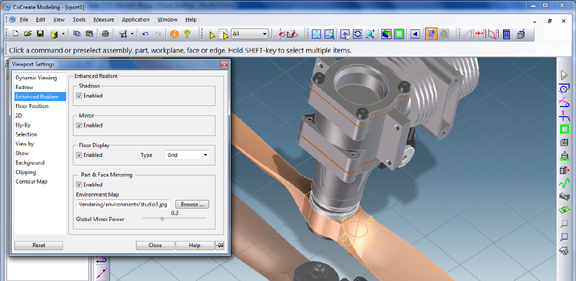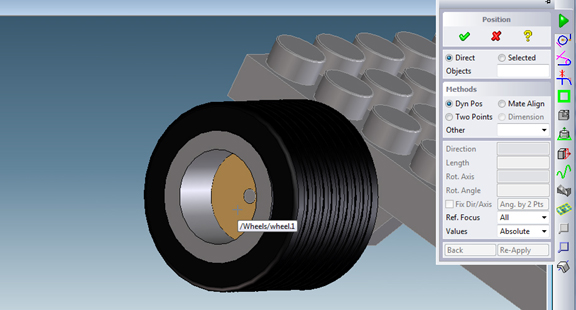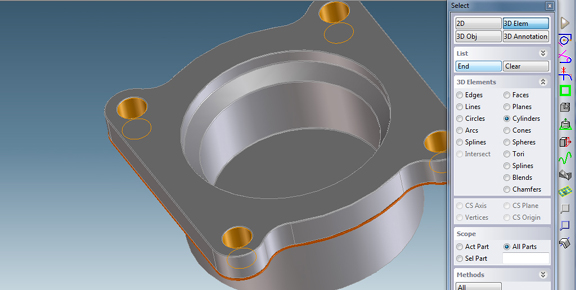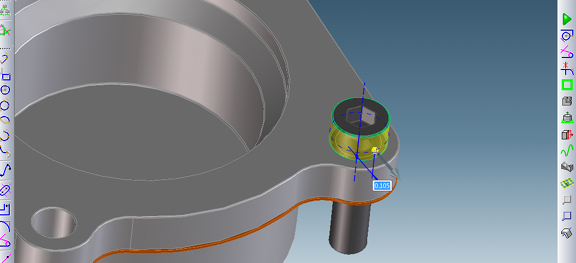October 5, 2010




If you, like many who’ve been trained in history- or feature-based modeling packages, are used to thinking of part modeling and assembly modeling as separate operations, PTC’s CoCreate has a surprise for you. In CoCreate, you work in a modeling session, which can accommodate a single part or multiple parts. Therefore, in the same modeling session, you could be working on a single part, all parts belonging to an assembly, or two unrelated parts.
To position or align items, you’ll use the Position tab. Here, you’ll have the option to Align Axis or Align. The latter can be used for aligning faces, for instance. You can manage the visibility of the different components loaded into your session by checking or unchecking the items in the navigation pane (docked to the upper-left corner by default). This will help avoid visual clutter if you’re working on a complex assembly.
The ability to edit or modify parts within an assembly gives you certain advantages. The visual clues and instantaneous updates ensure that your adjustments to a part (say, the length and radius or a shaft) don’t create clashes with adjacent parts and features. Since you could also be working on several unrelated parts, you’ll be prompted to specify the component (or components) you’d like to save (by selecting it with a mouse pointer) at Save command. This may take some time to get used to, as most CAD programs simply save the part or assembly in the display window when you invoke the Save command.
There is one notable difference between CoCreate and Solid Edge with Synchronous Technology, another direct modeler. When dealing with imported geometry, Solid Edge assumes you’d like to maintain the parallel constructions, coplaner positions, and geometric symmetries found in your model. Accordingly, the software preserves these relationships and lets you edit them together (for example, changing the radius of a hole on the left corner will automatically be duplicated on the identical hole in the opposite corner). By contrast, CoCreate makes no such assumptions. So if you’d like to maintain these relationship in CoCreate, you’ll have to select these features and transform them together.
Editing a single face of feature is straightforward in CoCreate—you pick it with your mouse pointer and nudge it with the Copilot (the control device with directional arrows) to move it, taper it, shrink it, or enlarge it. But if you need to select several components (say, several cylindrical faces inside a series of holes), you could use the Tools > Select palette. Here, you’ll be prompted to specify whether you’d like to select by edge, surface, splines, arc, or another method. You’ll also need to Start the selection, then End it when you’ve picked all the components you’d like to include. This method lets you edit symmetrical features as a group, thus allow you to apply uniform transformation to them (for example, modifying the diameters of a series of holes).
The common method used for selecting multiple items—Shift + click—works in most cases. After making the selection, you may right-click to activate the transformation or editing choices available to you. Personally, I find the direct selection much simpler than using the Select palette, which requires a fair amount of time familiarizing with its options. The numerous selection methods and choices available on the Select palette (cone, tori, blend, spline, to name but a few) could be overwhelming for newcomers.
CoCreate 17.0 lets you customize your view window through Edit > Settings > Viewport Settings. This gives you the option to turn on or turn off edges, wireframes, vertices, and ground reflections. You can choose to work in a fully rendered mode with ground plane reflections and shadows turned on, but it may be best reserved for the nearly final stages where you need to visualize the design realistically. Otherwise, the computing demand may slow down your model’s rotations and tumbles.
For more, watch the video report below or read the first part of the series on CoCreate, First Encounter (published August 25, 2010), covering part modeling in the software.
Subscribe to our FREE magazine, FREE email newsletters or both!
About the Author
Kenneth Wong is Digital Engineering’s resident blogger and senior editor. Email him at [email protected] or share your thoughts on this article at digitaleng.news/facebook.
Follow DE





